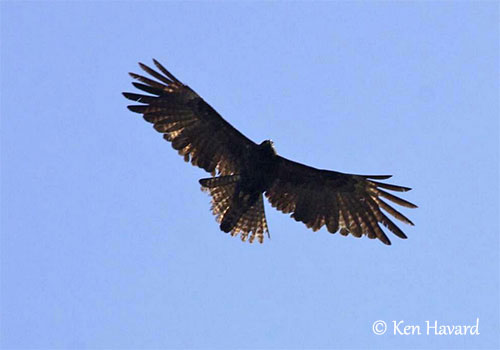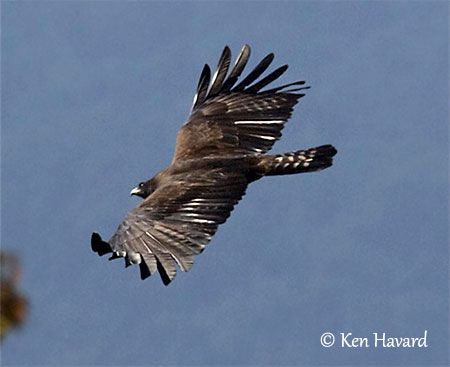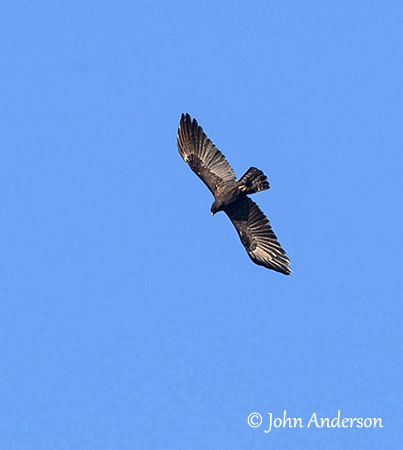
Fr: Aigle noir
Ang: Black Eagle – Indian Black Eagle
All: Malaienadler
Esp: Águila Milana
Ita: Aquila nera
Nd: Indische Zwarte Arend
Sd: svartörn
Photographers:
John Anderson
John Anderson Photo Galleries
Ken Havard
My Bird Gallery & Flickr gallery 1 & Flickr gallery 2
Text by Nicole Bouglouan
Sources:
HANDBOOK OF THE BIRDS OF THE WORLD Vol 2 by Josep del Hoyo-Andrew Elliot-Jordi Sargatal - Lynx Edicions - ISBN: 8487334156
L’ENCYCLOPEDIE MONDIALE DES OISEAUX - Dr Christopher M. Perrins - BORDAS - ISBN: 2040185607
A Field Guide to the Birds of South-East Asia by Craig Robson. New Holland Publishers. ISBN: 9781780090498
A photographic guide to Birds of Vietnam, Cambodia and Laos by Peter Davidson. New Holland Publishers. ISBN: 9781847731418
Global Raptor Information Network - Working to Conserve Birds of Prey in nature
Black Eagle: First breeding record in Malaysia
Wikipedia, the free encyclopaedia
Black Eagle or Indian Black Eagle
Ictinaetus malaiensis
Accipitriformes Order – Accipitridae Family
INTRODUCTION:
The Black Eagle is a large forest eagle found from Pakistan and Indochina to the Malay Peninsula. This elegant raptor has almost entirely black plumage, long wings and tail. It is very agile in flight, both when hunting and displaying.
It frequents broadleaved evergreen forests and adjacent open areas. It typically feeds on mammals, reptiles, amphibians, insects, birds and eggs. They are known to hunt in pairs.
At the beginning of the breeding season, the Black Eagle performs aerial displays involving steep dives and chases between mates.
The Black Eagle is described as rare to uncommon. The species is threatened by deforestation causing a slow decline of the population. But currently, it is not globally threatened.

DESCRIPTION OF THE BIRD:
Biometrics:
Length: 69-81 cm
Wingspan: 164-178 cm
Weight: 1000-1600 g
The Black Eagle has almost entirely black plumage, with slightly paler rump and variable pale coloration around the eyes and at base of outer primaries on the underwing. Tail and flight-feathers show narrow pale grey bars.
The bill is black with yellow cere. The eyes are dark brown. Legs and feet are yellow with black talons, but the claws are not as curved as those of other eagles.
Male and female are similar.
The juvenile has pale buffish head, neck and underparts with heavy blackish streaks. On the underwing, the coverts are pale buffish with dark streaks, whereas flight-feathers and tail show pale barring. Some pale-tipped feathers are visible on upperparts and upperwing-coverts. The bare parts are like in adults.
SUBSPECIES AND RANGE:
The Black Eagle has two subspecies very similar to each other.
I.m. perniger is found in extreme NE Pakistan and N India, Nepal, Bhutan, Assam and W and N Myanmar. It also occurs in C India, Odisha, Western Ghats and N and S Eastern Ghats, and Sri Lanka.

I.m. malaiensis (described above) occurs in CS and SE China and Taiwan, S through Indochina and Malay Peninsula to Greater Sundas, Sulawesi and Moluccas, and also Butung, Banggai Islands and possibly Sula Islands.
HABITAT:
The Black Eagle frequents lowland, evergreen and montane forests, from sea-level up to 3,300 metres of elevation, sometimes higher. It favours the forests with good forest cover on slopes and mountainous country.
CALLS AND SONGS: SOUNDS BY XENO-CANTO
The Black Eagle gives a shrill yelping “wee-a-kwek”. The most common call is a repeated, hoarse, piercing “kheeee kheeee kheeee…” mainly heard during the courtship displays.
BEHAVIOUR IN THE WILD:
The Black Eagle feeds on mammals including rats, both terrestrial and flying squirrels, bats and monkeys. It also eats reptiles, amphibians, insects, birds and eggs.
This raptor is a nest-predator, and often picks up eggs from bird nests thanks to the claws and the wide gape. It is also known to snatch up entire nests from their support, and bringing them to a feeding perch to eat chicks and/or eggs.

The Black Eagle soars over the habitat when hunting, by quartering low over the forest canopy. It usually flies at slow speed to spot the prey. This type of flight is relatively easy for the bird, thanks to the long primaries and the broad hands with well-defined “fingers”.

At the beginning of the breeding season, the Black Eagle performs beautiful aerial displays. The display flight involves steep dives through a U loop, up to near vertical stall. During the dive, the eagle pulls its feathers close to the body, involving a teardrop shape.
Chases between mates through the forest are also observed, and they also “dance” in the air with undulating flight.
The Black Eagle is mainly sedentary with some altitudinal movements during winter in Nepal.
It soars with the wings held in V, often spiralling softly downwards into forest clearings.

REPRODUCTION OF THIS SPECIES:
The breeding season varies according to the range, with November/January in S India, and later in the north, October/April in Bhutan, November/February in Sri Lanka and April/August in Java.
The Black Eagle builds a large stick nest with a platform made with thick twigs of about 100-120 centimetres wide. This large structure is placed in tree fork with dense canopy above, usually in tall tree overlooking a steep valley. A pair may have several maintained nests used year after year.
The female lays one, rarely two, whitish to pinkish eggs with reddish-brown dense markings. The incubation lasts 35-40 days. Fresh leaves are added to the nest every day. The young eagle fledges two months after hatching.
PROTECTION / THREATS / STATUS:
The Black Eagle is threatened by deforestation throughout the range. It is described as uncommon to fairly common, depending on the range, and the species is relatively widespread.
The population was estimated to number 10,000 individuals in 2001. It is slowly declining due to ongoing deforestation.
But the Black Eagle is not globally threatened, and currently evaluated as Least Concern.
